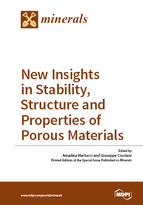New Insights in Stability, Structure and Properties of Porous Materials
A special issue of Minerals (ISSN 2075-163X).
Deadline for manuscript submissions: closed (15 December 2016) | Viewed by 58663
Special Issue Editors
Interests: crystallography and crystal-chemistry of zeolite-like minerals and synthetic porous materials; mineral physics (e.g. ferroelasticity, high pressure behavior); environment (e.g. water remediation); energy (e.g. solar energy harvesting and storage, solar perovskites, electrode for solar cells); cultural heritage; catalysis (e.g. titania, ceria, etc.); sensors; ceramics; cements; building materials (e.g. lime production); single crystal and powder diffraction both with conventional X-rays and large-scale facility radiations (synchrotron X-rays and neutrons); Rietveld refinement; temperature- and time- resolved in situ study of their structural behavior upon heating/desorption/dehydration; high pressure; micro-computed tomography
Special Issue Information
Dear Colleagues,
Porous materials (such as zeolites, clay minerals, and assemblies of oxide nanoparticles) are of great importance in many technological and environmental processes, such as catalysis, adsorption, separation and ion exchange, because of their unique pore topologies, tunable structures, and the possibility to introduce active reaction sites. The goal of this Special Issue is to provide a platform for scientists to discuss new insights in stability, structure and properties of porous materials, as well as in innovative aspects in their processing and applications. The emphasis is on the relationships between the structure and/or chemical composition and the specific physical properties of these materials, their role in mineralogical, technological, green and sustainable processes, as well as energy applications. We particularly wish to highlight works that explore physical, chemical and structural characterization of porous materials, synthesis of crystalline phases with pores in the appropriate range, structure-property relationships at ambient conditions, but also at low and high temperatures and/or at high pressures, adsorption and diffusion of mobile species in porous materials, host/guest interactions and confinement effects, ion exchange, modelling in geological and environmental processes, new insights in processing and applications.
Prof. Dr. Annalisa Martucci
Prof. Dr. Giuseppe Cruciani
Guest Editors
Manuscript Submission Information
Manuscripts should be submitted online at www.mdpi.com by registering and logging in to this website. Once you are registered, click here to go to the submission form. Manuscripts can be submitted until the deadline. All submissions that pass pre-check are peer-reviewed. Accepted papers will be published continuously in the journal (as soon as accepted) and will be listed together on the special issue website. Research articles, review articles as well as short communications are invited. For planned papers, a title and short abstract (about 100 words) can be sent to the Editorial Office for announcement on this website.
Submitted manuscripts should not have been published previously, nor be under consideration for publication elsewhere (except conference proceedings papers). All manuscripts are thoroughly refereed through a single-blind peer-review process. A guide for authors and other relevant information for submission of manuscripts is available on the Instructions for Authors page. Minerals is an international peer-reviewed open access monthly journal published by MDPI.
Please visit the Instructions for Authors page before submitting a manuscript. The Article Processing Charge (APC) for publication in this open access journal is 2400 CHF (Swiss Francs). Submitted papers should be well formatted and use good English. Authors may use MDPI's English editing service prior to publication or during author revisions.
Keywords
- Porous materials
- Zeolites
- Clay minerals
- Oxide nanoparticles
- Structure-property relationships
- Processing and applications







